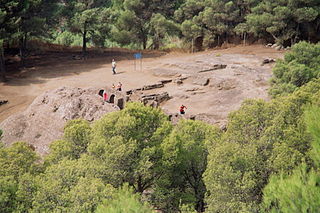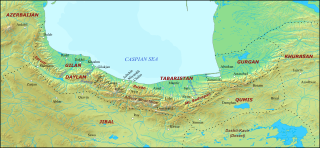
A vizier is a high-ranking political advisor or minister in the Near East. The Abbasid caliphs gave the title wazir to a minister formerly called katib (secretary), who was at first merely a helper but afterwards became the representative and successor of the dapir of the Sassanian kings.

A wali is most commonly used by Muslims to indicate a saint, otherwise referred to by the more literal "friend of God".

Abū Isḥāq Muḥammad ibn al-Wāthiq, better known by his regnal name al-Muhtadī bi-'llāh, was the Caliph of the Abbasid Caliphate from July 869 to June 870, during the "Anarchy at Samarra".
The ten to whom Paradise was promised were ten early Muslims to whom, according to Sunni Islamic tradition, the Islamic prophet Muhammad had promised Paradise.
al-Walid ibn Uqba ibn Abi Mu'ayt was the governor of Kufa in 645/46–649/50 during the reign of his half-brother, Caliph Uthman.

Bobastro was a castle of Roman origin, rebuilt as the headquarters of Umar ibn Hafsun during his rebellion against the Caliphate of Córdoba in the 9th century. Its ruins lie in the Province of Málaga, Spain.
Abu Imran Musa ibn Isa ibn Abi 'l-Hajjal-Fasi was a Moroccan Maliki faqīh born at Fez to a Berber or Arab family whose nisba is impossible to reconstruct.
Roger Mervyn Savory was a British-born Professor Emeritus at the University of Toronto who was an Iranologist and specialist on the Safavids. His numerous writings on Safavid political, military history, administration, bureaucracy, and diplomacy-translated into several languages have had a great impact in understanding this period.
Muhammad ibn al-Qasim was an official of the Abbasid Caliphate who served briefly as vizier in July–October 933 under Caliph al-Qahir. He hailed from a family of Nestorian Christian origin that had served in the caliphal bureaucracy since late Umayyad times, and was the son, grandson, great-grandson and brother of viziers.
Peri J. Bearman is an academic scholar of Islamic law. She was the Associate Director of the Islamic Legal Studies Program at Harvard Law School. She is also currently the Editor-in-Chief and Islam section editor for the Journal of the American Oriental Society (JAOS).
The Sanjak of Nakşa Berre or Naxos was a second-level Ottoman province encompassing the central and southern Cyclades islands, and named after the two largest islands of Naxos and Paros. The sanjak encompassed the territory of the former Duchy of Naxos, which had been tributary to the Ottomans since 1537, but was not formally incorporated into the Empire until after 1579, when the last Duke, Joseph Nasi, died. The sanjak formed part of the Eyalet of the Archipelago at least by 1600, but is no longer attested after the late 18th century. Aside from the sanjakbey at Naxos, two other beys, at Milos and Santorini, are recorded in 1629. With the outbreak of the Greek War of Independence in 1821, the islands came under Greek control.

The Sanjak of Kocaeli was a second-level Ottoman province with capital at Iznikmid/Izmid.

Abu'l-Makarim Muslim ibn Qirwash also known by the honorific title Sharaf al-Dawla, was the Uqaylid emir of Mosul and Aleppo. He died in June 1085.
Malik ibn Tawk ibn Malik ibn 'Attab at-Taghlibi was an Arab Abbasid official during the reigns of caliphs al-Wathiq and al-Mutawakkil. He is best known as the founder of the fortress town of al-Rahba on the western banks of the Euphrates, part of the present-day Syrian town of Mayadin.

Ruyan, later known as Rustamdar (رستمدار), was the name of a mountainous district that encompassed the western part of Tabaristan/Mazandaran, a region on the Caspian coast of northern Iran.
Muhammad ibn Khalid ibn Barmak was one of the Barmakids, a family of Iranian functionaries who rose to great power under the Abbasid caliph Harun al-Rashid.
Abu Ali Muhammad ibn Muhammad al-Jayhani was a vizier of the Samanid dynasty.
Abu Abdallah Ahmad ibn Muhammad al-Jayhani was a vizier of the Samanid dynasty.








